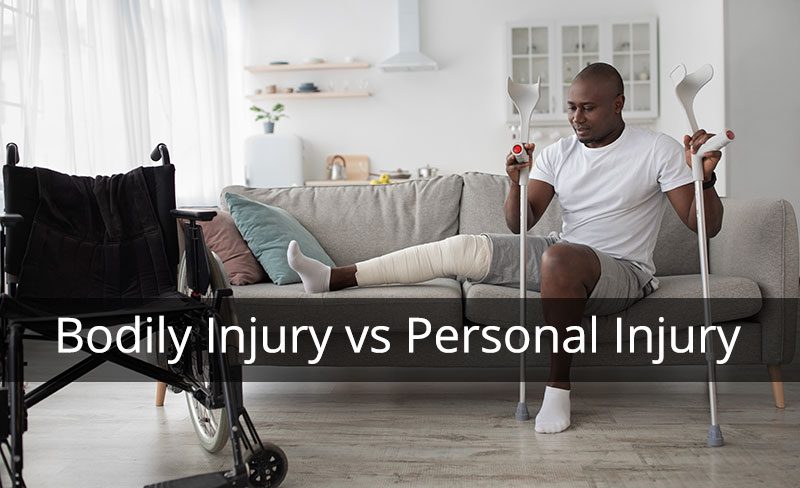Whenever you or someone you love suffers, you want to seek justice. However, filing a claim and entering the legal world can be overwhelming and confusing, especially with similar-sounding terms like bodily injury and personal injury.
However, with the following information, you can understand these terms, their implications, and how to proceed with your legal case.Â
What Is the Meaning of Personal Injury?
Personal injury is an extremely common type of civil litigation case that has two players:
- defendant
- plaintiff
In such cases, the plaintiff suffered harm at the hand of the defendant. These injuries could be physical, emotional, or even reputational. Personal injury examples often include malpractice, forced evictions, car accidents, defamation, false arrests, and fraud. Even slipping and falling on a business’s icy sidewalk can provoke a personal injury claim.
Essentially, if anyone feels that another person has been negligent or has intentionally sought to harm them, they can file a personal injury claim. To settle these civil law disputes, the defendant generally compensates the plaintiff, possibly covering medical bills.Â
Sometimes the accident may result in the death of the victim. In such situations, the plaintiff is usually someone representing the deceased.
Of course, the defendant won’t be able to pay for medical procedures, so the settlement is often a large monetary amount.
Negligence in a Personal Injury Claim
As previously mentioned, personal injury claims arise due to intent or negligence.
However, most accidents result from carelessness and negligence of the party at fault.
It’s rarely intentional.
Malpractice cases, harm caused from defective products, slip-and-fall cases, dog bites, and some vehicular accidents revolve around the defendant’s negligence. Perhaps a doctor did not follow appropriate procedures, or maybe a dog owner knowingly left an aggressive dog off the leash.
Even drunk-driving car accidents can be a personal injury claim based on the driver’s negligence.
Required Evidence of Negligence
Of course, for a personal injury claim based on negligence to hold up, you need to provide sufficient evidence of carelessness.
First and foremost, provide proof that the defendant was responsible for providing proper care.
In medical cases, this duty is quite evident as doctors and medical professionals work to care for individuals.
However, in slip-and-fall cases or dog bites, it may be harder to prove this responsibility.
Once you have established the defendant’s duty of care towards you, you must show proof that they failed to comply with that responsibility. And, of course, you must prove that their negligence caused you harm or losses.
Personal Injury Details to Consider
If you are considering filing a personal injury claim, there are several considerations to keep in mind.
Responsibility for the Injury
We already discussed that you must provide sufficient evidence proving the defendant’s responsibility. If you cannot produce such evidence, the claim might fall through.
Consider whether or not you have enough evidence to proceed with the case, or if your evidence is mostly hearsay. You don’t want to begin a legal process without supporting evidence.
If you are unsure of how to get such evidence or how to proceed, talk to a personal injury lawyer.
Lawful Limitations
Each state determines a specific timeframe for you to develop a personal injury claim called a statutory limitation.
Check what your state’s limitations are or discuss your possibilities with a lawyer. Ensure you file within the timeframe, giving yourself plenty of time to gather evidence and papers.
Liability
When you file a personal injury claim, you are stating that the defendant holds full responsibility for damages and losses.
However, the final decision of who holds liability for the incident falls to a jury.
They may decide that you hold partial or complete liability for the incident, limiting or eliminating your compensation. As such, it’s crucial to have all the necessary documentation mentioned above.
Compensation in a Personal Injury Case
When determining potential compensation, you must first determine what type of damages you or a loved one have incurred.
They may either be economic or non-economic.
Economic damages include things that come with a price tag. For example, medical bills, rehabilitation costs, income loss, and out-of-pocket expenses. You can use a personal injury calculator to get an idea of your potential compensation.
However, you can also consider non-economic damages in your calculations. These are things that don’t have a price tag, so it is difficult to create one. Consider your emotional distress, hurt, and suffering. While there are no monetary implications here, you discuss potential amounts with a lawyer.
The average amount of compensation for a personal injury case is approximately $52,900. You can receive much more – or much less – depending on the type of case and the damages received. Keep in mind that your state regulations may put a cap on the maximum compensation amount.
Keep in mind that 67% of personal injury cases never even go to trial and end up with an out-of-court settlement. With the right evidence and a top lawyer, you can get compensation without even going to court.
What Does Bodily Injury Cover?
Personal injury claims cover all types of damages and losses, one of which is bodily injury.
In short, bodily injury is not a type of claim, but a subset of personal injury losses.
Bodily injury is what it sounds like – injury to one’s body due to the actions or negligence of another person. Bodily injury examples include broken bones, cuts, diseases and sicknesses, disfigurement, or even death resulting from these injuries.
While personal injury claims can include bodily injury, people most often try to reach a bodily injury settlement after a car accident.
What Is a Bodily Injury Settlement?
Just like a personal injury settlement, you and the defendant can arrive at a settlement decision where you receive compensation for your physical injuries.
A bodily injury settlement may include the cost of the following:
- Out-of-pocket expenses related to your injuries
- Medical expensesÂ
- Income or wage losses from missed work
- Treatment procedure expenses, like x-rays and surgeries
- Physical therapy costs
- Transportation expenses, like the cost of an ambulance ride
When calculating compensation for a bodily injury settlement, consider including future losses and expenses. For example, if you have excessive injuries that require continued treatment, you can include their estimated cost in your final settlement.
Of course, the final compensation amount depends on the severity of your injuries. Make sure to keep track of any medical bills, receipts, and other evidence to prove the full extent of your injuries.
What Is Bodily Injury Liability?
We mentioned before that a jury may find you completely or partially liable in an accident. Similarly, if you are involved in an accident that results in bodily injury, you may be responsible.
As such, bodily injury liability involves insurance to cover other people’s injuries when you are liable.
This liability insurance can cover some or all of the following, depending on your plan and the incident:
- Funeral costs
- Doctor’s bills
- Rehabilitation costs
Keep in mind that there may be a limit to how much your bodily injury liability insurance can cover.
PIP vs. Bodily Injury Liability
Is personal injury protection (PIP) the same as bodily injury liability?
In short, no. These insurance coverage plans are not the same.Â
While bodily injury liability insurance covers other people’s costs when you – the plan holder – is at fault, PIP does not look at who is at fault.
PIP coverage can help pay for your injuries and possibly other’s, even if you caused the accident. Often called no-fault coverage, a PIP plan can pay for medical treatments, funeral costs, and potentially lost wages.
Depending on the state, people may be required to have a personal injury protection plan, bodily injury liability, or both. Make sure you have the appropriate coverage to avoid huge bills in the case of a future accident.
Keep in mind, though, that costs accrued from an accident may exceed what you PIP policy can cover. Also, having a PIP doesn’t mean you can’t pursue additional losses via the other party’s insurance. If you are looking for a plan that goes above and beyond regular car insurance, consider a personal umbrella protection plan (PUP), that covers personal injury, false arrest, property damage, and more.
When involved in a personal injury claim – especially one that involves bodily injury – make sure to closely review your insurance coverage and talk with a lawyer about possible compensation.
So, What is the Difference between Personal Injury and Bodily Injury?
Personal injury is a type of civil claim, while bodily injury refers to a specific type of damage, particularly in a car accident.
From an insurance perspective, a bodily injury insurance policy covers the other party’s injuries if you are at fault for the accident. Personal injury protection covers your injuries regardless of who caused the accident.
Contact Stoy Law Group
If you are ever in a circumstance where you’ve suffered injuries, hiring a personal injury attorney is the best way to get compensated. They’ll take you through the legalities of injury law and get you a fair settlement.Â
If you have any questions or would like to speak to a lawyer, contact our office today.














